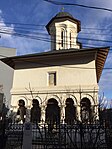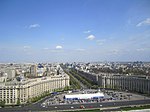Matei Basarab National College

Matei Basarab National College (Romanian: Colegiul Național "Matei Basarab") is a high school in Bucharest, Romania, located at 32 Matei Basarab Street, Sector 3. It opened in November 1860, one of two secondary schools to open that year in the Romanian capital, the other being Gheorghe Lazăr Gymnasium, in order to supplement the older Saint Sava High School.Alumni include Aurel Baranga, Nicolae Cajal, Paul Georgescu, Alexandru Graur, Petre V. Haneș, Petre Iorgulescu-Yor, Ștefan Octavian Iosif, Constantin Levaditi, Adrian Maniu, Gheorghe Marinescu, Constantin Miculescu, Vintilă M. Mihăilescu, Ion Mincu, Costin Murgescu, Ștefan S. Nicolau, Miron Nicolescu, Dimitrie Paciurea, Lucrețiu Pătrășcanu, Radu D. Rosetti, George Topîrceanu, Ilarie Voronca, George Vraca, Duiliu Zamfirescu, and George Oprescu.Former faculty include Emanoil Bacaloglu, George Călinescu, Mitiță Constantinescu, Eugen Lovinescu, Constantin Moisil, Gheorghe Munteanu-Murgoci, Dumitru Panaitescu-Perspessicius, Dimitrie D. Pătrășcanu, Ion Popescu-Voitești, Constantin F. Robescu, Ioan Slavici, Theodor Speranția, and G. Dem. Teodorescu.
Excerpt from the Wikipedia article Matei Basarab National College (License: CC BY-SA 3.0, Authors, Images).Matei Basarab National College
Strada Matei Basarab, Bucharest Centrul Civic (Sector 3)
Geographical coordinates (GPS) Address Nearby Places Show on map
Geographical coordinates (GPS)
| Latitude | Longitude |
|---|---|
| N 44.4303 ° | E 26.1135 ° |
Address
Colegiul National "Matei Basarab"
Strada Matei Basarab 32-34
030674 Bucharest, Centrul Civic (Sector 3)
Romania
Open on Google Maps











